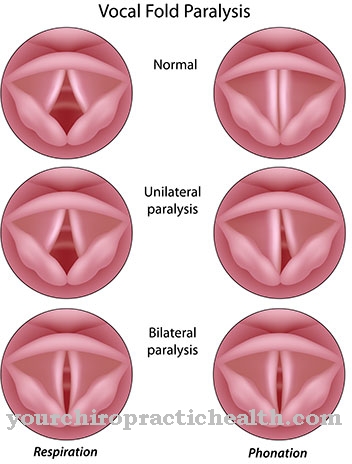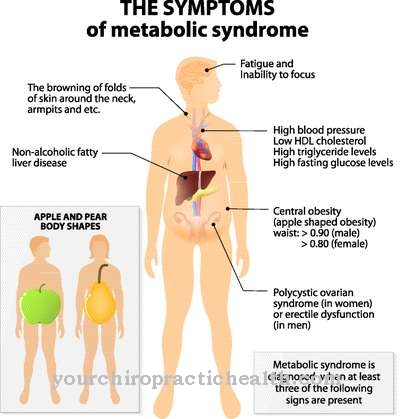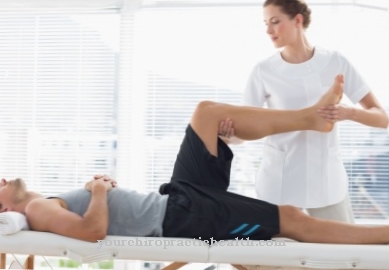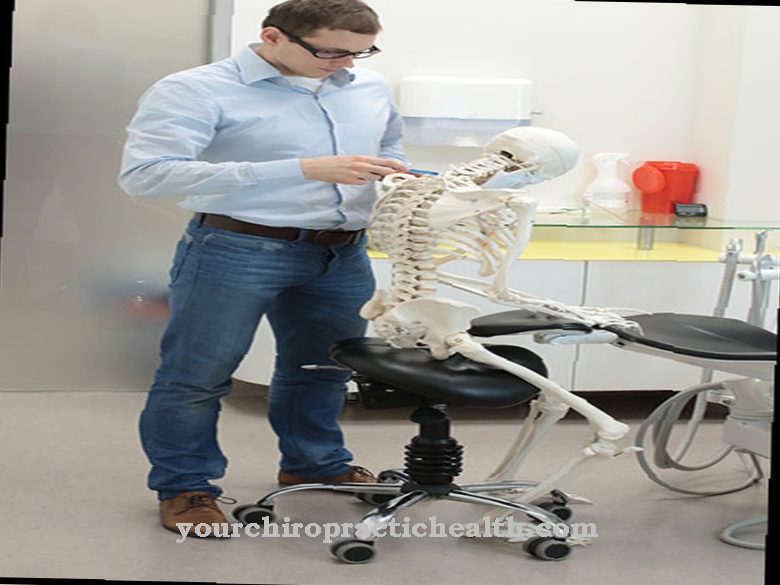The Juberg-Marsidi syndrome is a hereditary disease that is associated with mental retardation and physical disorders. The syndrome is rather rare, with one disease per million births. The cause is a mutation in the ATRX gene.
What is Juberg-Marsidi Syndrome?

© BillionPhotos.com - stock.adobe.com
The Juberg-Marsidi syndrome, also as Smith-Fineman-Myers Syndrome or X-linked mental retardation-hypotonic facies syndrome I. is a hereditary disease. It belongs to the group of "syndromes with an association between intellectual deficit and hypotonic face". The disease was first described in 1980 by the American paediatricians Richard C. Jubert and I. Marsidi. Since then, several cases of illness in unrelated families have been described. Overall, the disease is very rare, with one case per million births.
causes
Juberg-Marsidi syndrome is inherited. It is an x-linked recessive inheritance. In the case of x-linked recessive inheritance, the gene carrying traits is located on the X chromosome. This means that the disease is inherited in a sexually linked manner. As a rule, women are only carriers of the disease.
For a woman to fall ill, both the father and mother would have to have a sick X chromosome in them. If there is only one diseased X chromosome, a recessive inherited disease does not prevail. Women are therefore normally exclusively carriers. This means that they carry the diseased gene, but do not have any corresponding disease characteristics themselves. Since men, unlike women, only have one X chromosome, they are affected by the disease if the damaged X chromosome was transferred from the mother.
Roughly, it can be said that with a sick father, all sons are healthy and all daughters are carriers. If the mother carries the damaged X chromosome, 50 percent of the sons fall ill. In turn, 50 percent of the daughters would be conductors. The cause of the syndrome is a mutation in the so-called ATRX gene in the chromosome region Xq25 approximately in an interval of 19.8Mb.
Symptoms, ailments & signs
The main symptom of Juberg-Marsidi syndrome is severe intellectual disability. This manifests itself through below-average cognitive abilities and thus also a clear limitation in feeling and mind. The intelligence of the affected children is significantly reduced. The growth and development disorders already begin in the womb, so that the children are born hard of hearing or deaf.
The malformed faces of the sick children are striking. The facial features are rather coarse with a rather narrow face, the lips very prominent. The lower lip appears drooping. The upper central incisors appear just as prominent. Generally the teeth are quite far apart. The eyebrows are bushy, the eyelid axes are oblique, the eyelid slits, however, rather narrow. At the corner of the eye there is a fold of skin lying in front of the eyelids. This fold of skin is called the epicanthus.
The bridge of the nose is broad and flat with an extended tip of the nose. This nasal deformity is also known as the saddle nose. Overall, the head of sick children is smaller than the head of healthy children. The auricles of the affected children are also malformed. One speaks here of auricular dysplasia. The growth disorders continue in development, so that the children remain small. The muscles are weak and muscle spasticity may occur.
There is camptodactyly on the hands. This is a flexion contracture of the middle joints of the little finger and, in rare cases, of the ring finger. This is thought to be caused by a shortening or shrinking of the tendons and tendon sheaths. In addition to camptodactyly, clinodactyly can also occur in Juberg-Marsidi syndrome. In clinodactyly, a phalanx is bent at the side in the hand skeleton.
Another symptom of Juberg-Marsidi syndrome is microgenitalism. The penis and scrotum are underdeveloped. This is also called a micropenis. There is also testicular dystopia, i.e. an abnormal position of the testicle. The testicle is temporarily or permanently outside the scrotum.
Diagnosis & course of disease
The symptoms of Juberg-Marsidi syndrome are noticeable, but since the disease is very rare, the diagnosis is usually not made directly. The first indications are deformities of the skull, a low birth weight, deformities of the genitals and hearing loss. In the course of child development, physical development disorders and limitations in cognitive development are added. Certainty as to whether the disease is really Juberg-Marsidi syndrome can only be provided by a genetic test in the child and parents.
Complications
The Juberg-Marsidi syndrome usually leads to considerable mental and physical disorders and complaints in the patient. These can significantly limit the life and everyday life of the person affected. In most cases, patients also rely on family or caregiver care. Even in childhood there are disturbances in growth and development.
Furthermore, there is also a severe intellectual disability. As a result, children in particular can become victims of bullying or teasing. The patient's facial features are also changed and short stature occurs. The muscles are also relatively weak and the patient's resilience is significantly reduced due to the Juberg-Marsidi syndrome.
It is not uncommon for a micropenis to occur. The head of those affected is also significantly smaller than that of healthy people. Furthermore, there is a hearing loss and discomfort to the eyes. A causal treatment of Juberg-Marsidi syndrome is not possible. Therefore, only the symptoms of the syndrome can be limited, with various therapies being necessary.
There are no particular complications. Juberg-Marsidi syndrome can reduce the patient's life expectancy. In addition, the patient's parents often need psychological treatment.
When should you go to the doctor?
Parents should see a doctor with their children as soon as the first physical or mental abnormalities appear in the offspring. If there are developmental delays, difficulties within various learning processes or if a reduced intelligence is perceived in direct comparison to children of the same age, a doctor should be consulted. If the hearing ability is impaired, the ears are deformed or the muscles are generally poorly developed, it is advisable to initiate check-ups. Physical peculiarities, adhesions or deformities are to be presented to a doctor as soon as possible.
If the child does not learn to walk or cannot use their limbs properly, the cause must be determined. There is cause for concern if the fingers are shortened, the shape of the hand or the joints are abnormal or if the child is short. An early diagnosis is essential for the effectiveness of possible therapies. Therefore, a doctor should be consulted at the first irregularity.
Boys who suffer from Juberg-Marsidi syndrome also show growth disorders of their sex. A micropenis or abnormalities in the testicles are among the criteria that indicate disease and should be investigated. If the children feel overwhelmed by playful activities in everyday life, if they do not become independent despite all efforts or if they have persistent problems understanding, a visit to the doctor is advisable.
Therapy & Treatment
There is no specific therapy for Juberg-Marsidi syndrome. Treatment is purely symptomatic. Occupational therapy and physiotherapy can support the children in their development. Hearing specialists and ophthalmologists are also usually part of the treating team due to the impairment of the sensory organs. Surgical interventions may be indicated to correct malocclusions and visual disturbances. Most of the time, the sick children also need a hearing aid.
The earliest possible therapeutic support is essential in the treatment of Juberg-Marsidi syndrome. Only in this way can the children be encouraged in good time and possible development deficits can still be compensated in good time.
Outlook & forecast
Juberg-Marsidi syndrome has an unfavorable prognosis. This syndrome represents a mutation in the patient's genetics. Legal requirements prohibit scientists and researchers from interfering with or changing human genetics. This means that a cure is not possible for the person affected.
In their treatment, doctors concentrate on creating an improvement in wellbeing and quality of life. Unnecessary interventions that can only improve the appearance are avoided. The sooner a comprehensive treatment plan is drawn up and various therapies begin, the better the chances of success for funding and the reduction of development deficits.
Since the disease is characterized by a severe intellectual disability, despite all efforts, no state of health can be achieved that enables a life without medical help and daily support. The person concerned needs medication and all-day care for life. Various functional disorders as well as physical changes occur with this disease and lead to a severe impairment in coping with everyday obligations.
Surgical interventions are performed to improve natural functions. Every procedure is associated with the associated risks and side effects. Complications and new disorders can arise. In many cases, the existing complaints trigger secondary diseases that must be taken into account when making an overall prognosis.
prevention
Juberg-Marsidi syndrome cannot be prevented. With the help of prenatal diagnostics, genetic defects can be detected at an early stage. Heterozygous diagnostics can be used to determine whether one of the two parents carries the defective gene and could pass it on to the child in the event of reproduction. In Germany, the genes of unborn babies may only be tested for certain diseases in exceptional cases. The genome of the embryo can often only be differentiated from the genome of the mother. However, prenatal genetic tests are ethically controversial.
Aftercare
The follow-up measures for Juberg-Marsidi syndrome are usually very limited or are not available to the person affected. With this disease, the patient must first and foremost consult a doctor at an early stage so that there are no further complications or other complaints that could possibly further reduce the quality of life. Therefore, the early detection and treatment of Juberg-Marsidi syndrome is paramount in this disease.
Since it is a hereditary disease, it cannot be completely cured. If you want to have children, however, genetic testing and counseling should always be carried out so that the syndrome does not recur in the descendants. In most cases, the symptoms of Juberg-Marsidi syndrome are treated by means of physiotherapy or physiotherapy.
Many of the exercises from such therapy can be repeated at home, which can further alleviate the symptoms. In the case of visual disturbances, those affected should wear visual aids so that these disturbances do not worsen further. Especially with children, parents must ensure that the visual aids are used correctly. In the case of psychological disorders, intensive discussions with your own parents or with relatives and friends are very helpful.
You can do that yourself
Patients with Juberg-Marsidi syndrome are clearly impaired in their physical and mental development and are often not able to lead an independent life. This means that most of the possibilities for self-help are unnecessary, since it is primarily the custodians who have an influence on the patient's condition. Although the quality of life is enormously restricted by the disease, the physical and mental well-being of the patient is often improved through care appropriate to the disability.
With regard to mental retardation, those affected usually attend a special school facility. The educators there take into account the individual intellectual state of the patient and encourage him accordingly as best as possible.In school and other care facilities, those affected usually get to know helpful social contacts that make it easier to deal with the rare disease and increase the perceived quality of life.
Certain symptoms can be relieved with appropriate medication, with parents paying attention to the correct dosage. In general, patients usually visit various doctors several times a year who monitor the various symptoms of the disease and order further therapies. Physical disability prevents specific types of sport from being practiced, but some sporting alternatives remain. A physiotherapist supports the person concerned in strengthening their motor skills, which make everyday life easier.



























